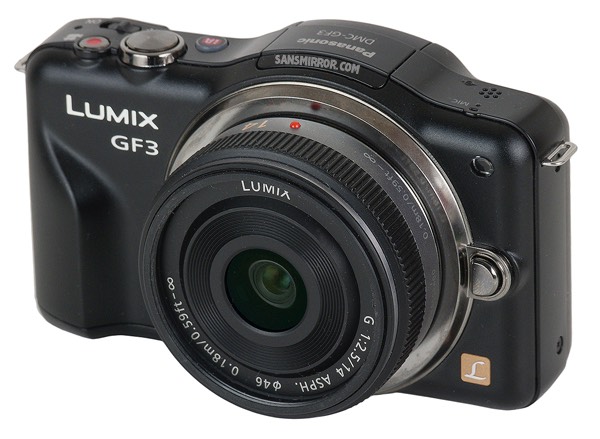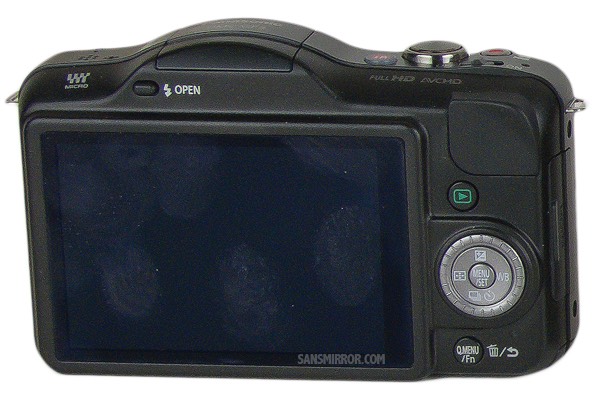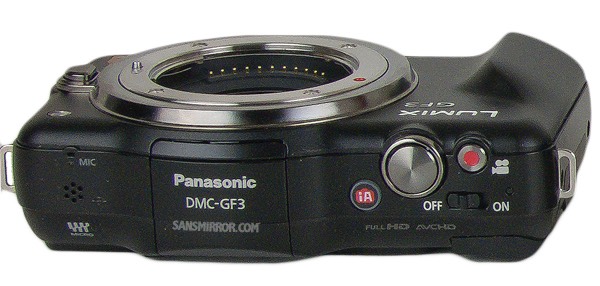
What is It?
The Panasonic GF3 is the third in the GF series, and judging by the trend, GF now means "entry level." Let's go back for a moment: the GF1 was Panasonic's first attempt at a mirrorless camera without a built-in EVF (e.g. the first one that wasn't DSLR-like, but more compact camera like). The range of features and controls on the GF1 put it squarely in the "enthusiast" market. Next up we got the GF2, which seemed to remove some of the controls and simplify the camera, and which was a bit smaller.
Now we have the GF3, which removes all but the basic controls and makes the smallest, most compact Panasonic interchangeable lens camera yet.
By "all but the basic controls," I mean it. Grand total: shutter release, record movie button, iAuto button, on-off switch, flash release button, playback button, Q.MENU/Fn/Delete/Return button (yes four functions), and a control pad with a dial and a four additional buttons via edge presses. One last addition: the LCD is a touchscreen.
With a 12mp sensor and so little direct control in such a small package, it's clear that Panasonic wants new mirrorless users upgrading from compacts to pick this camera, but frankly, a lot of higher end users should take a closer look at it, too. It makes a small, light backup body for the other m4/3 cameras, and with one of the smaller lenses (pancake primes or the new 14-42mm X) it's close to a shirt-pocket camera; call it jacket pocket. Yet deep down, it doesn't give up a lot over its more expensive and control-laden siblings.
The big news on the back is the 3" 460k dot touch sensitive LCD, which is fixed in place. We don't get the swivel flexibility of the G3, but we do get the touch capabilities. I wouldn't call the LCD bright, but it's reasonably usable outdoors.
While shooting you can set crops of 4:3, 3:2, 1:1, and 16:9. The sensor always crops, so at 16:9 you get a bit less than 12mp output. The sensor itself is basically the GF1 sensor with some tweaking (focus speed has been improved).
The menus are slightly simplified: 4 pages for Record, 3 for Video, 5 for Custom Setting, 4 for Setup, and 3 for Playback, but that's a lot for a camera targeted at the more entry user. The entry user will feel a bit overwhelmed by the choices, partly due to Panasonic's odd language choices. The serious user will find there's a lot of capability and flexibility buried in the menus.
The GF3 is no GH2 when it comes to motion, but it does have some reasonable video specs, including 17Mbps 1080i/60 (NTSC regions; PAL users get 1080i/50).
In terms of performance specifications, the GF3 is a low-to-mid-pack shooter: 2 to 3 fps at full resolution, 7 shot raw buffer (unlimited with JPEG with a fast card), 1/160 flash sync speed, 1/4000 top shutter speed. ISO starts at 160 and can be set to up to 6400.
Despite the very simplified design, there's not a lot missing from this camera over its predecessors. So the real question is whether you like the handling of the simplified design or not.
How's it Handle?
Without a Mode dial, you may wonder how you set modes. Press the MENU button, select Rec Mode, rotate the dial around the Direction pad to the mode you want. It's no more cumbersome than the Sony NEX style of setting exposure mode, indeed it pretty much mimics it in some ways.

Most of the rest of the things you'd want to set are accessible via the Q.Menu (Quick Menu), either via the Q.Menu button or the touchscreen virtual button. Simple enough. Exposure compensation is one of the Direction pad edge presses (coupled with the dial around the Direction pad). Aperture or Shutter Speed is set via the dial. Everything fairly simple and direct.
Overall, I wasn't particularly bothered by the simplification. I can shoot with the GF3 just about as fast as I can the GX1, the Sony NEX-5, the Nikon V1, and most other mirrorless cameras I've reviewed. If anything, the GF3's control structure is a bit better than the E-PL3 and E-PM1 by a tiny bit. I did miss the top command dial, but don't dismiss this camera just because it doesn't have a button you expect.
Panasonic has pretty much perfected the Quick Menu concept. On the GF3 you have only two ways of triggering it: the QMENU button or the virtual touchscreen button (ala G3).
Like the G3, the touchscreen itself is a bit cluttered. With everything active, there are a lot of indicators and icons on the screen that can distract you from framing.
While not quite as complex as the other Panasonic cameras, the menu system is deep and wide. This is a bit of a good thing for serious users considering the simplified GF3, as it does give you some level of customization over the camera (at the expense of menu complexity). If you've used one of the other Panasonic bodies, you won't find much missing in the GF3 menus, which is a little odd, but as I note, welcome for serious shooters. Entry level shooters will probably avoid the menu system for the most part, as it's 19 pages (!) of terminology and complexity that will initially flumox them. Thankfully, you can pretty much avoid the menus for basic stuff.

Non-cluttered and well organized come to mind when contemplating the GF3, with only the menu system detracting a bit from that. The inclusion of a plastic front grip is nice, but overall the camera is a little slippery to hold. You'll notice that if your hands are damp or there's a lot of moisture in the air (foggy days). While I like the plain look of the GF3, I kind of wish it had a more textured surface to it.
How's it Perform?
Battery: This is a small battery, only 940mAh, so don't expect a lot out of it. You'll want to carry extra batteries, for sure. The battery is not the same as the GX1, G3, or GF2, by the way.
Flash: Surprisingly useful, though not powerful. The GN of 6.3m at base ISO means only f/2.1 at about 10 feet (3m) in complete darkness. Like the other Panasonic bodies, my measurements say it doesn't quite achieve that, but it's only about a half stop off. You're at a level where adding flash will make a meaningful difference in most situations you'd try to use it for fill. Still, with fast primes on the GF3 you don't have enough horsepower to light even small groups at night when they're 20 feet (6m) away. Think of the flash as good for single portrait or fill flash work. For groups or further subjects, it wimps out quickly.
Focus: Not bad, but not quite as good as the current m4/3 state-of-the-art (GX1, E-P3). For single focus (static subjects), most people will find it quite decent. For tracking moving subjects, it's close to a Fail.
Image Quality: Most people will consider this camera against the Olympus E-PM1. The E-PM1 will win the image quality battle by a small bit. As seems to be a repeating case now, the Panasonic Venus engine isn't get quite the same level of JPEG quality out of the same sensor as Olympus' TruPic. This shows up as a very faint level of noise even at base ISO on the Panasonic, and then at above ISO 800 starts to escalate as a highly visible difference. ISO 3200 is blotchier on the GF3 than on the E-PM1, and at ISO 6400 it's no contest: the Panasonic output is clearly blurrier and blotchier compared to the E-PM1, which itself is starting to get a bit blurry and blotchy.
That's strange, because the raw output of the GF3 is very slightly better than my E-PM1. The E-PM1 seems to have a bit more color noise to it than my GF3, especially at ISO 1600 and 3200. Overall, I can get very reasonable images out of ISO 1600 GF3 raw files. At ISO 3200 I start to struggle to get the kind of image I want; we noise level is just starting to get out of the correctable without major consequences range.
I was a little surprised to see that Olympus got clearly more dynamic range out of the same sensor than Panasonic did. This shows up mostly in the highlights, but there's a teeny bit more in the shadows too. It even seems to show up in raw files, though nowhere near at the same difference level.
That said, the Panasonic's image quality is competent. People wouldn't be buying this camera for ultimate image quality, but because of size mostly. Panasonic has picked a nice balance point. Raw shooters will get a bit more than expected from an entry level camera.
Final Words
I liked the GF3 much more than I thought I would. It's a decent jogging camera, as it slips into my winter jogging jacket's pocket very easily (if you've got one of the smaller lenses on it). That's actually how I discovered the slipperiness: I sweat when I jog, a lot. I have to be careful when I grab the camera that it doesn't slip away, but the built-in front grip helps a lot there.
It's not the fastest mirrorless camera in the world, it's not the best image quality camera in the mirrorless world, it doesn't have the most pixels of any mirrorless camera, but it does take very decent pictures and doesn't get in your way while doing so. It's a spouse-friendly camera (press the iA button before handing it to someone who isn't a photographer), it doesn't have controls that get changed when you handle it roughly (slipping mode dials, etc.). All in all, it's a perfectly competent little package, with the emphasis on little.
2018: this model is out of production and no longer available new. But used copies can easily be found. There's no specific current model that's an exact update, but consider the GX9.
